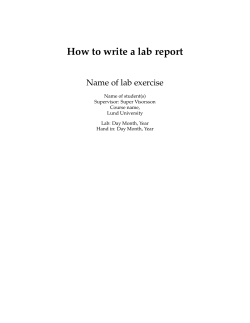
Raw data from FRA measurements NOVA Technical Note 15
NOVA Technical Note 15 Raw data from FRA measurements Case study: how to monitor the raw signals measured by the impedance analyzer module during a frequency scan? 1 – Raw impedance data Most modern electrochemical instrumentations provide direct access to processed data during an impedance spectroscopy measurement. This data is usually displayed as a Nyquist plot or as a Bode plot (see Figure 1). Figure 1 – A typical display format for electrochemical impedance spectroscopy data (left: Nyquist plot; right: Bode plot) Alternatively, the data can also be displayed in formats derived from the fundamental calculated values of the following signals: • • • • • • Frequency (Hz): the frequency of the applied sinewave, in Hz. Time (s): the time coordinate, in seconds, corresponding to the measured data point in the spectrum. Z, modulus (Ohm): the modulus of the measured impedance. Z’, real part (Ohm): the real part of the measured impedance. -Z”, imaginary part (Ohm): the imaginary part of the measurement impedance. -Phase (°): the phase shift. During a frequency scan, the values of these six signals are experimentally derived from a synchronized measurement of the potential and current sinewaves in the time domain (see Figure 2). 1|Page NOVA Technical note 15 Figure 2 – Example of raw time domain data measured during a frequency scan (frequency: 1 Hz) This time domain information is then transformed into the frequency domain by a Fast Fourier Transformation, or FFT (see Figure 3). Figure 3 – Example of frequency domain data obtained by Fourier transformation of the data presented in Figure 2 (frequency: 1 Hz) The impedance data is finally computed from the frequency domain information, providing a set of values of the six fundamental signals, for the applied frequency. The raw time domain and frequency domain information is usually discarded after each new data point. However, this raw data can be used to gather more 2|Page NOVA Technical Note 15 information on the behaviour of the system being investigated. It is therefore very useful to consider plotting and storing this raw data. This technical note will show how to store and display the raw data during a FRA frequency scan in NOVA. The discussion developed in this technical note applies to the raw time domain information, since this data carries the most useful information. The frequency domain data can be useful to noise sources or signals contributing to the raw time domain data at frequencies other than the frequency of interest. Note The data shown in Figure 3 shows how the effect from 50 Hz noise can be easily identified in the frequency domain data. From the introduction of this technical note, it should be obvious that the raw time domain data contains valuable information. In this section, two possible ways to exploit this raw data will be illustrated. 1.1 – Resolution plot In order to process the data in the software, the FRA module needs to convert the raw analog sinewaves into digital representations of these sinewaves. This task is performed by dedicated Analog-to-Digital converters (ADC) present on the FRA module. These converters are fitted with gain circuits that can be used to amplify the AC signals as much as possible in order to maximize the resolution. By looking at the raw sinewave data in a resolution plot, the actual quality of the data can be quickly estimated (see Figure 4). The FRA will try to amplify the signal in order to reach at least 34% resolution on both channels, if possible. When is it not possible anymore, the FRA will try to digitize the signals with the highest possible resolution. When this resolution is low, the signal to noise ratio of the processed data will be degraded (see Figure 5). 3|Page NOVA Technical note 15 Figure 4 – Example of a resolution plot obtained from raw time domain data (with significant resolution on both signals) 4|Page NOVA Technical Note 15 Figure 5 – Example of a resolution plot obtained from raw time domain data (with low resolution on the current signal) 1.2 –Lissajous plot The Lissajous plot is now considered as obsolete. This plot used to be the standard way to perform impedance measurements a few decades ago, when computer controlled impedance analyzers were not readily available. A Lissajous plot is constructed by plotting the measured AC potential on the X axis and the measured AC current on the Y axis, as shown in Figure 6. 5|Page NOVA Technical note 15 Figure 6 – An example of Lissajous plot Figure 7 shows the same Lissajous plot, with additional marker lines added, indicating the location of points O, A, B and D. 6|Page NOVA Technical Note 15 B O D A Figure 7 – The Lissajous plot shown Figure 6, with additional marker lines indicating points O, A, B and D Using these points, it is possible to calculate the impedance according to: Z = ∆V OA = = 10kΩ ∆i OB OD sin ( −φ) = − ⇒ −φ = 33° OA Although this type of plot is not useful for the determination of impedance data as such, it is still quite useful since it allows the user to verify that the response to the applied amplitude respects the linearity condition. The linearity condition stipulates that the applied AC amplitude is small enough that the response of the electrochemical cell can be, in first approximation, considered to be linear. This condition typically holds when the amplitude is in the range a few mV. Using the Lissajous plot, it becomes possible to verify if the linearity condition is respected at each frequency (see Figure 8). 7|Page NOVA Technical note 15 Figure 8 – Linearity test by Lissajous plot (left, symmetry is respected; right, symmetry is not respected) The linearity condition is verified when the Lissajous plot is symmetrical with respect to the origin of the plot. The Lissajous plots shown in Figure 8 show two different situations. The plot on the left hand side corresponds to a situation where the linearity condition is respected. The plot on the right hand side show the raw data from a measurement in which the applied amplitude generates a non linear response. 1.3 – Limitations An important limitation of the Lissajous plots is that they cannot be used in combination with multi sine measurements. 2 – Implementation To illustrate how to add a Resolution plot and a Lissajous plot to an impedance measurement, the standard Autolab FRA impedance potentiostatic procedure will be used. This procedure is located in the Autolab group. Double click it to load it into the procedure editor (see Figure 9). 8|Page NOVA Technical Note 15 Figure 9 – The Autolab FRA impedance potentiostatic procedure Open the FRA editor by clicking the potentiostatic command (see Figure 10). button next to the FRA measurement 9|Page NOVA Technical note 15 Figure 10 – Opening the FRA sampler editor A new window, called FRA Editor, will be displayed (see Figure 11). Figure 11 – The FRA Sampler window 10 | P a g e NOVA Technical Note 15 Using this editor it is possible to select the additional signals to be sampled and stored during the frequency scan, for each individual frequency. The additional signals are specified on the Sampler section (see Figure 12). Figure 12 – Adding signals to the measurement using the Sampler section For both the Resolution plot and the Lissajous plot, the time domain information is required. Add this signal to the measurement by sliding the selection toggle as shown in Figure 12. Additional plots can be added to the measurement using the Plot section of the FRA editor (see Figure 13). 11 | P a g e NOVA Technical note 15 Figure 13 – Plots can be defined on the Plots section of the FRA editor The available plots are shown in this section of the editor, together with the plot location. By default, only the Nyquist and the Bode plots are selected. Set the location of the Lissajous plot to plot #3 and the Resolution vs time plot to plot #4 (see Figure 14). Figure 14 – Adding the Resolution vs time and Lissajous plot to the FRA editor 12 | P a g e NOVA Technical Note 15 Note The Lissajous and Resolution vs time plots are only available if the Sample time domain option is active on the Sampler section of the FRA editor. Click the button to close the editor and return to the procedure editor. The FRA measurement potentiostatic command will be updated and the signals selected in the Sampler section as well as the plots defined in the Plots section will be added to the procedure (see details in Figure 15). Figure 15 – The modified FRA measurement potentiostatic command 3 – Final adjustments Once the plots have been added to the procedure, the location of these plots can be edited, as well as their respective plot options. Since this part of the procedure editing falls outside of the scope of this tutorial, no further details are provided. Using proper plot settings, it is possible to display the data as shown in Figure 16 during an impedance measurement. 13 | P a g e NOVA Technical note 15 Figure 16 – A practical example of the use of the Lissajous and Resolution plots in an impedance measurement (plot #1 – Nyquist, plot #2 – Bode, plot # 3 – Lissajous, plot #4 – Resolution plot) These additional plots provide direct information about the signal to noise ratio of the measured sinewaves and about the linearity of the response with respect to the applied perturbation. 4 – Post measurement checks Once the measurement is finished, the data will be available in the analysis view for further handling (see Figure 17). Figure 17 – The measured data is available at the end of the experiment for further analysis The global Nyquist and Bode plots are immediately available for plotting. However, it is possible to expand the FRA frequency scan item in the data explorer frame to reveal the raw measured data for each individual frequency in the scan (see Figure 18). 14 | P a g e NOVA Technical Note 15 Figure 18 – The recorded raw data is also available, for each frequency, in the analysis view 5 – Conclusions Visualizing the raw data during an impedance measurement provides a considerable amount of additional information that can be used to verify several important experimental variables, like linearity, data quality, noise, interference, etc. It is therefore advisable to consider these additional plots whenever studying a new system with impedance spectroscopy. 15 | P a g e
© Copyright 2025










